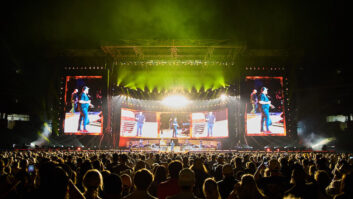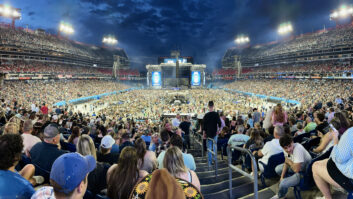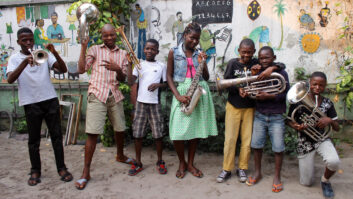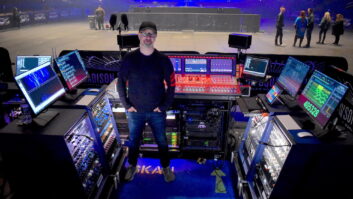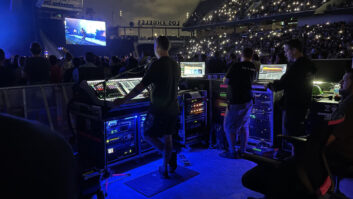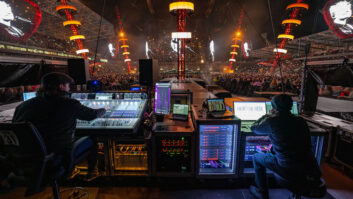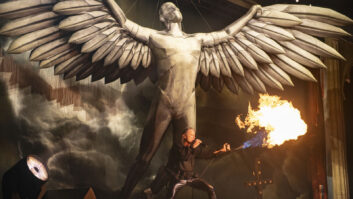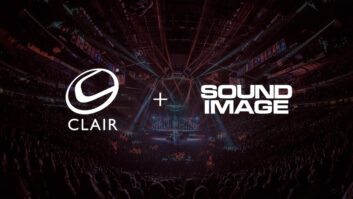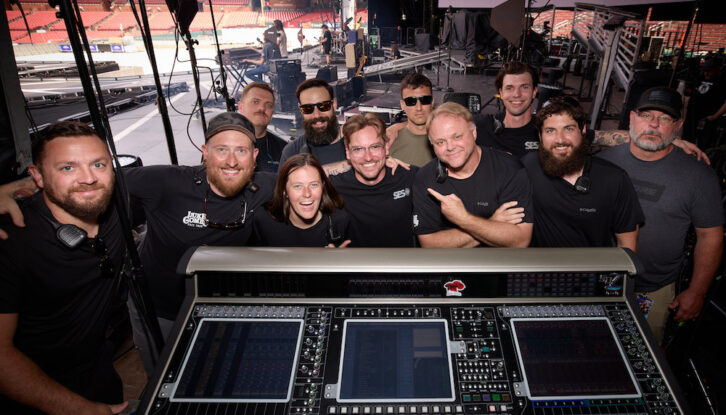
In the conclusion of our coverage of Luke Combs’ world tour, the audio team talks monitors, the massive Outline GTO PA system, and shotgunning beers with Super Bowl champ Patrick Mahomes. Make sure you don’t skip Part 1!
Over at stage right, monitor engineer Michael Zuehsow uses his own Quantum7 desk to look after 18 wireless in-ear monitor mixes, plus a number of other wired mixes for video, lighting and crew, adding up to nearly 30 ear packs at every show. While making use of the console’s Nodal Processing, Mustard channels and its Spice Rack offerings, the desk is also outfitted with a DMI-KLANG card. While KLANG is typically used for immersive monitor mixing, Zuehsow uses it to provide widening for numerous stereo sources, keeping them from piling on top of each other and fighting for space in the in-ear mixes. The KLANG setup also allows him to make use of a DPA 5100 mobile 5.1 surround microphone that resides at FOH; while the mic is there for post mixing captures, Zuehsow uses it in the moment to better portray the audiences’ enthusiasm in the IEM mixes.
Hanging well above the stage on the U.S. stadium run was the largest system of Outline GTO loudspeakers used so far for a major American tour. Having offered Outline products for more than a decade, SES fielded a system based around GTO and Mantas boxes, with a design created by systems tech Joseph Lefebvre. “I’ve used GTO in stadiums and other large-format setups and have been really happy with it, so I knew its capabilities and power,” said Lefebvre. “When it came time to design this stadium rig, I thought it would fit best and it’s been fine.”
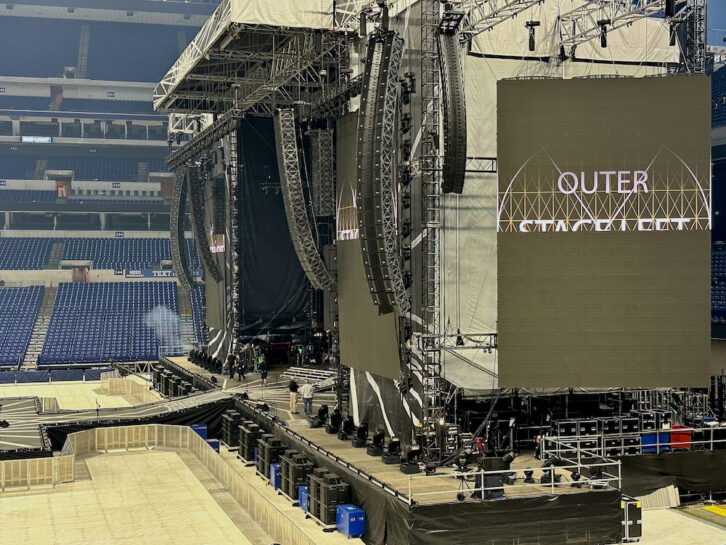
Faced with having to cover 220 degrees from the stage, the system actually used more GTO loudspeakers in the side hangs than on the main left-right. The main hangs each had 16 Outline GTO 15-inch boxes and a single GTO-DF, with eight GTO-LOW hung behind them for low end; meanwhile, each side hang comprised 20 GTO over one GTO-DF. “The main hang has a good bit of downfill on it, so it’s covering the lower bowl, just before where the delays outside the endzone start taking over,” said Lefebvre. “The three delay hangs are a mix of six GTO 15-inch over eight of the GTO C-12, which is a 12-inch. Then there’s rear-hangs because we sell seats pretty far around—I have a 24-box array of Mantas, an 8-inch box, that is taking care of the people further back. It’s in close proximity to the sidehang just adjacent to it, and that’s working out better than I thought it would. All the low end and low mid that I’m getting from that big sidehang is helping with the Mantas, so it’s working well.”
Ensuring that the system covered each venue was Outline’s OpenArray simulation software and its Armonía control software, which worked in conjunction with Newton processors on the front end. “I’ve had a lot of assistance from the guys at Outline in Italy for getting imported drawings into Open Array so I can figure out my deployment,” said Lefebvre. “It’s all run via the network program, Armonía; I have plenty of tools at my disposal there in terms of EQ-ing, filtering, FIR filters, shelves and all that stuff. For the front end, I have two Outline Newton 16+8 FPGA processors that get all my consoles in and then all my outs to the P.A. via AES with analog callback.”
For all the technology brought to bear on the tour, the focus remains on the music and connecting with the vast audiences, rather than big sets and the like. “Luke literally wants to walk out on stage and do the thing,” said front-of-house engineer Todd Lewis. “I guess the biggest gag we have would be on the song ‘1, 2 Many’—they basically stop the song, he grabs a beer and shotguns it. When we were at Arrowhead Stadium, [Kansas City Chiefs quarterback and reigning Super Bowl MVP] Patrick Mahomes came out and shotgunned one with Luke.”
The result is that after each show, everyone in the audience goes home having had a good time—one that is, despite the size of the venues, just as real and true as seeing a show up-close in a small club. That authenticity is on display every night. “If you come see a Luke show, you’re watching a band play,” said Lewis, “and I go for the live sound when I mix them. We get the heart and essence of the song really good, but it’s not perfect if you’re comparing to the album. It’s humans playing with each other, and that comes across. I make sure that it’s tight and it’s good, but it’s not the album—and if you expect that, go see a tracks band.”
